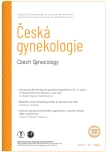Uterine inversion – some procedures to prevent reinversion
Authors:
S. Matsubara
Published in:
Ceska Gynekol 2023; 88(4): 308-309
Category:
Letters to the Editor
Dear Editors,
Uhlířová and Málek [1] reported a patient with postpartum uterine inversion who required laparotomic repositioning. Importantly, uterine inversion can recur after the successful repositioning [2–4], referred to as acute uterine reinversion. The inversion and its repositioning have already caused marked bleeding and circulatory collapse, and thus, reinversion-occurrence is life-threatening. How to prevent acute reinversion? Uhlířová and Málek state that uterotonics should be administered to prevent reinversion, with which I agree. I would like to add some procedures to prevent reinversion.
One solution is to extinguish “room” of reinversion. Intrauterine gauze-packing has been used for a long time; however, filling the entire uterine cavity with gauze requires some experiences. We have been using intrauterine haemostatic balloon to prevent reinversion [5]. Some balloons designed for intrauterine haemostasis (Bakri balloon) may be appropriate; however, any other balloons including Foley or condom catheters can be used in an emergent setting.
Another solution is to extinguish “exit” of reinverting uterus. We have been employing the “holding the cervix technique” for a long time, in which the anterior and posterior cervical lips are held by a sponge forceps, thereby closing the cervical canal [6,7]. There remains no exit of the reinverting uterus, preventing reinversion. However, this technique may not prevent “partial” or “incomplete” reinversion, in which reinverted fundal part remains intrauterine (not dropping out to the vagina through the cervical canal). If this becomes a concern, we usually employ the combination of Bakri balloon placement and holding the cervix technique [8]. Sponge forceps and Bakri balloon should be removed after 12–24 hours, when complete haemostasis is achieved [7,8].
While abdominal cavity is opened for laparotomic repositioning, as Uhlířová and Málek’s case, we usually employ uterine compression sutures after laparotomic repositioning. Any types of compression sutures may prevent reinversion, and we have long been using Matsubara-Yano (MY) suture [3,4,9]. A concern may arise: uterine penetration at compression sutures might cause adverse ischemic events to the uterus “already ischemic due to inversion”. Although this is theoretical, we propose “single transverse uterine-body suture”: only single transverse transfixation suture should be made in the uterine-body upper part (just below the fundus). This prevents reinversion. The suture is tied at the abdominal wall (not within the abdominal cavity) [10]. The suture (thread) can be removed from the abdominal wall after haemostasis is achieved, and thus thread does not remain intrauterine. This is a kind of “removable” uterine compression suture. Ischemic adverse events are expected to be less likely to occur.
In our department, the choice which of these procedures should be employed depends on the attending doctors’ judgements. There are no controlled studies on efficacy of these preventative procedures. Considering the rarity of the uterine inversion and reinversion and its emergent nature, randomized controlled trials may be impossible to perform. We have been employing them as departmental routine procedures. After their employment, we encountered no patients with reinversion. Thus, I believe that their effectiveness is time-tested. I recommend readers to attempt these procedures depending on the situation. All the detailed procedures are described with illustrations in the cited literature.
Acknowledgment
I previously described these techniques, which were cited. Our team touched these techniques also in other papers, which are retrievable through the articles cited here.
Prof. Shigeki Matsubara, MD, PhD
Department of Obstetrics and Gynecology, Jichi Medical University, Tochigi, Japan
Department of Obstetrics and Gynecology, Koga Red Cross Hospital, Ibaraki, Japan
Sources
1. Uhlířová M, Málek M. Laparotomic reposition of acute postpartal uterine inversion. Ceska Gynekol 2023; 88 (2): 92–94. doi: 10.48095/ cccg202392.
2. Mondal PC, Ghosh D, Santra D et al. Role of Hayman technique and its modification in recurrent puerperal uterine inversion. J Obstet Gynaecol Res 2012; 38 (2): 438–441. doi: 10.1111/j.1447-0756.2011.01720.x.
3. Matsubara S, Yano H, Taneichi A et al. Uterine compression suture against impending recurrence of uterine inversion immediately after laparotomy repositioning. J Obstet Gynaecol Res 2009; 35 (4): 819–823. doi: 10.1111/j.14 47-0756. 2008.01011.x.
4. Matsubara S, Baba Y. MY (Matsubara-Yano) uterine compression suture to prevent acute recurrence of uterine inversion. Acta Obstet Gynecol Scand 2013; 92 (6): 734–735. doi: 10.1111/j.1600-0412.2012.01513.x
5. Matsubara S. An intrauterine balloon for puerperal uterine inversion is not only for hemostasis but also for prophylaxis against reinversion: a letter to the editor. Int J Surg Case Rep 2022; 97: 107397. doi: 10.1016/j.ijscr.2022.107 397.
6. Matsubara S. „Holding the cervix“ technique: prophylaxis for acute recurrent uterine inversion. Arch Gynecol Obstet 2013; 288 (2): 463–465. doi: 10.1007/s00404-013-27 51-x.
7. Ogoyama M, Takahashi H, Usui R et al. Hemostatic effect of intrauterine balloon for postpartum hemorrhage with special reference to concomitant use of “holding the cervix” procedure (Matsubara). Eur J Obstet Gynecol Reprod Biol 2017; 210: 281–285. doi: 10.1016/ j.ejogrb.2017.01.012.
8. Matsubara S. Combination of an intrauterine balloon and the “holding the cervix” technique for hemostasis of postpartum hemorrhage and for prophylaxis of acute recurrent uterine inversion. Acta Obstet Gynecol Scand 2014; 93 (3): 314–315. doi: 10.1111/aogs.12 282.
9. Matsubara S, Yano H, Ohkuchi A et al. Uterine compression sutures for postpartum hemorrhage: an overview. Acta Obstet Gynecol Scand 2013; 92 (4): 378–385. doi: 10.1111/aogs.12 077.
10. Matsubara S. Letter to „Acute uterine inversion following an induced abortion”. J Obstet Gynaecol Res 2023; 49 (5): 1462–1463. doi: 10.1111/jog.15623.
Labels
Paediatric gynaecology Gynaecology and obstetrics Reproduction medicineArticle was published in
Czech Gynaecology

2023 Issue 4
Most read in this issue
- The efficacy of human papillomavirus vaccination in the prevention of recurrence of severe cervical lesions
- Therapeutical strategies for recurrent endometrial cancer
- Direct abdominal muscle diastasis and stress urinary incontinence in postpartum women
- Effect of umbilical cord drainage after spontaneous delivery in the third stage of labor

